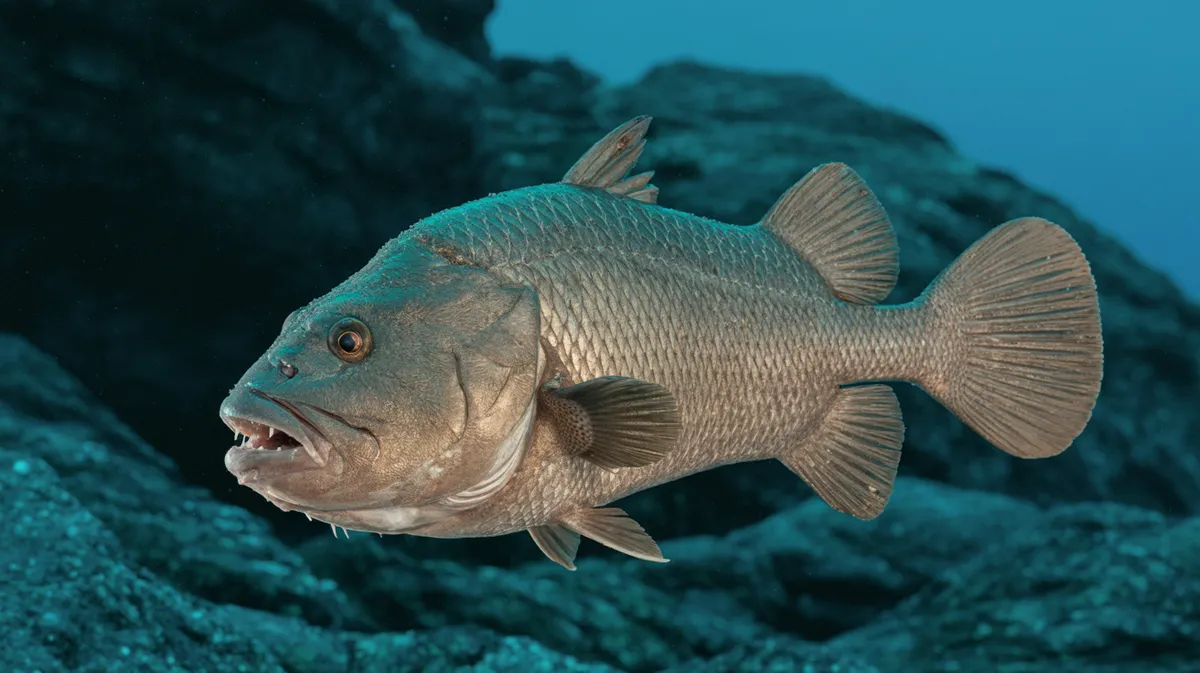
Atlantic Wolf Fish
Anarhichas lupus

Meet the Atlantic Wolf Fish
The Atlantic wolf fish is a large, elongated marine fish known for its powerful jaws and prominent canine-like teeth, which it uses to crush hard-shelled prey such as sea urchins, crabs, and mollusks. This impressive predator inhabits the cold, rocky bottoms of the North Atlantic Ocean, often at depths ranging from 20 to 500 meters. Its thick, eel-like body and mottled coloration offer excellent camouflage among rocks and seaweed. The wolf fish is solitary and territorial, spending most of its life in a single den or crevice.
Classification
Fish
Habitat
Cold, rocky coastal waters of the North Atlantic Ocean
Diet
Carnivore
Lifespan
12-20 years
Conservation
Near Threatened
Weight
10-18 kg
📖Fascinating Facts
Powerful Jaws
The Atlantic wolf fish has extremely strong jaws and sharp teeth, specialized for crushing the shells of hard-bodied prey.
Natural Antifreeze
Wolf fish have antifreeze proteins in their blood, which prevent their bodily fluids from freezing in very cold waters.
Homebodies
Unlike many fish, Atlantic wolf fish are highly territorial and often remain in the same rocky crevice for years.
📋Detailed Description
The Atlantic wolf fish (Anarhichas lupus) is a robust, elongated marine predator reaching lengths of up to 150 cm (59 in) and weights exceeding 18 kg (40 lbs). Its most distinctive anatomical features are its massive, conical canine teeth at the front of the jaws, followed by rows of molariform teeth adapted for crushing hard-shelled prey. The head is broad and slightly flattened, with small eyes set high, and the body tapers to a long, laterally compressed tail. The skin is covered by small, embedded cycloid scales, giving it a smooth appearance, and its coloration varies from slate blue to olive-brown, often with irregular dark bands or spots that provide camouflage among rocks and kelp. The dorsal fin runs almost the entire length of the back, while the pelvic fins are absent, a trait unusual among teleosts. Atlantic wolf fish are primarily benthic, residing in crevices or self-excavated dens on rocky substrates at depths from 20 to 500 meters, though most commonly found between 50 and 200 meters. They are solitary and highly territorial, rarely venturing far from their chosen shelter. Their physiology is adapted to cold, oxygen-rich waters, and they possess antifreeze proteins in their blood to prevent ice crystal formation, allowing survival in temperatures as low as -1.5°C (29.3°F).
💡 Did you know?
The Atlantic wolf fish plays a crucial role in controlling populations of sea urchins, helping to maintain the balance of kelp forest ecosystems.
🔬Research & Sources
🎭Behavior & Social Structure
Atlantic wolf fish are predominantly nocturnal, emerging from their dens at dusk to forage. They exhibit sit-and-wait predatory behavior, remaining motionless for extended periods before ambushing prey. Their diet consists mainly of hard-shelled invertebrates such as sea urchins, green crabs, large mollusks, and occasionally starfish and small fish. Using their powerful jaws and specialized teeth, they crush shells with ease, playing a crucial ecological role in controlling populations of benthic invertebrates. Social interactions are minimal outside the breeding season, as individuals are highly territorial and aggressive toward conspecifics. They maintain and defend their dens vigorously, using threat displays such as gaping and head shaking. Daily routines involve periods of inactivity interspersed with foraging excursions, and they are known to return to the same den for years.
👶Reproduction & Life Cycle
Atlantic wolf fish are oviparous, with a distinct annual breeding season typically occurring from September to December, varying slightly by latitude. During courtship, males become more active and may leave their dens to locate receptive females. After mating, females lay large, adhesive eggs (up to 10,000 per clutch, each 5–6 mm in diameter) in secluded crevices or under rocks. Males exhibit pronounced parental care, guarding the eggs for up to four months until hatching, fanning them with their fins to ensure oxygenation and prevent fungal growth. This extended brooding period is unusual among marine fishes and results in relatively high offspring survival. Larvae are demersal upon hatching and remain near the substrate, gradually dispersing as they grow.
🛡️Adaptations & Survival
The Atlantic wolf fish exhibits several key adaptations for life in cold, rocky marine environments. Its antifreeze glycoproteins prevent blood from freezing in subzero temperatures. The absence of pelvic fins enhances maneuverability in tight crevices. Its dentition is highly specialized: anterior canine teeth for gripping, and posterior molariform teeth for crushing shells. The thick, muscular jaws generate significant bite force, enabling predation on armored prey. Camouflaged coloration and a sedentary lifestyle reduce predation risk. Physiologically, they have a slow metabolism suited to cold, nutrient-rich waters, and their ability to remain motionless for extended periods conserves energy.
📚Research Sources
🎨Cultural Significance
While not a major target of commercial fisheries, Atlantic wolf fish are occasionally caught for their firm, white flesh, which is considered a delicacy in some northern European countries. In Scandinavian folklore, the wolf fish is sometimes associated with strength and resilience, and its striking appearance has made it a subject of curiosity among divers and naturalists. Its teeth and jaws have occasionally been used as curios or in traditional crafts. The species also features in local ecological education as an indicator of healthy benthic ecosystems.
🔬Recent Research & Discoveries
Recent research has focused on the wolf fish's antifreeze proteins, with potential biomedical applications in cryopreservation. Genetic studies have revealed significant population structuring across the North Atlantic, suggesting limited dispersal and highlighting the need for region-specific management. Ecological research underscores their role as keystone predators in controlling populations of sea urchins and crabs, which, if unchecked, can lead to kelp forest degradation. Ongoing monitoring programs in the US and Canada are assessing population trends and bycatch rates, while habitat mapping efforts aim to identify and protect critical spawning and denning sites.
🎥Wildlife Videos

WOLF FISH DVD DOCUMENTARY
Follow Ivan Mikolji as he takes you on expeditions to video tropical fish in the wild Please like and subscribe to our channel.
Mikolji

Underwater Killers (Full Episode) | World's Deadliest
Nat Geo WILD gets up close with underwater killers lurking in our oceans. At first glance these underwater assassins may appear ...
Nat Geo Animals

The Depths of the North Sea: Life in the Cold Abyss | Secrets of the Seas Ep. 1 | 4K UHD Documentary
"Seas in Motion - Wonders of the North Sea" unveils the dynamic ecosystem of one of Europe's most vital bodies of water.
space and science

Wolf Fish Making Love - Unique footage: FOR THE FIRST TIME on film!
What do you think, do fish have feelings? Here is unique and rare footage of wolf fish making love. For the first time on film wolf ...
Crystal Water Film Production

Wolf Fish : Unveiling the Mysteries of the Deep | Wolf Fish | Marine Life | Ocean Conservation
The Ocean's Apex Predator: Wolf Fish Exposed Wolf Fish: The Most Feared Fish in the Sea Into the Jaws of the Wolf Fish The Wolf ...
World's Stories

INFINITE OCEANS | A Journey Through the World's Oceans - Full Documentary
Dive into the depths of the oceans with an incredible 4K documentary, fully narrated in english and filled with captivating visuals!
NatureVista - English
🌍Habitat Information
The Atlantic Wolf Fish typically inhabits Cold, rocky coastal waters of the North Atlantic Ocean environments. Atlantic Wolf Fishs have adapted to their environments with specialized features and behaviors.
Primary Habitat:
Cold, rocky coastal waters of the North Atlantic Ocean
More detailed habitat information will be available soon.
🛡️Conservation Status
The Atlantic Wolf Fish is currently classified as Near Threatened. Conservation efforts are crucial for preserving this species for future generations.
Common Threats:
- 🏠Habitat loss and fragmentation
- 🌡️Climate change impacts
- 🎯Hunting and poaching
- 🏭Human-wildlife conflict
⚠️Threats & Conservation Challenges
Atlantic wolf fish populations are declining due to a combination of overfishing (both targeted and as bycatch in trawl fisheries), habitat degradation from bottom trawling, and climate change, which alters benthic community structure and water temperature. Their slow growth, late maturity (typically 6–8 years), and low reproductive rate make them particularly vulnerable to exploitation. The IUCN lists the species as Near Threatened, with regional assessments indicating significant declines, especially in the western North Atlantic. Conservation challenges include insufficient species-specific management, lack of protection for critical habitats, and limited public awareness.
🔬Scientific Classification
Scientific Name
Anarhichas lupus
Classification Hierarchy
🔍 About Taxonomic Classification
Taxonomic classification is a hierarchical system used by scientists to classify and organize living organisms based on shared characteristics and evolutionary relationships.
The system moves from broad categories (Kingdom) to increasingly specific ones, with each animal's scientific name typically consisting of its Genus and species.
📝Community Notes
Share your observations and insights about the Atlantic Wolf Fish with our community of wildlife enthusiasts.
Join Our Community
Sign in to share your observations and connect with fellow wildlife enthusiasts.
Sign In to ContributeNo community notes yet
Be the first to share your observations about the Atlantic Wolf Fish!
Explore Atlantic Wolf Fish
Select a tab above to learn more about this amazing animal.
📸Photo Gallery
No photos available for this animal yet.
🌟Discover More Wildlife
Continue your journey of discovery with more fascinating animals from our database
